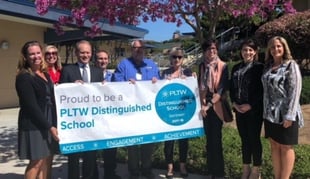Corey Coble has been a classroom teacher for over 25 years. He currently teaches PLTW Gateway unit Automation and Robotics, as well as 7th grade science and history, at Creekview Ranch School in Roseville, California. Corey is a Google-Certified Trainer and has always enjoyed implementing technology into the classroom. In his spare time, Corey enjoys hiking with his family or perfecting a healthy new recipe that his kids will enjoy.
My Project Lead The Way story began in the spring of 2017. At that time, our district had one school implementing PLTW, with the plan to offer PLTW to all the middle schools the following year. I was so excited to bring this program to my 7th grade classroom, and I started the 2017-18 school year teaching both Design and Modeling and Automation and Robotics after a fantastic PLTW Professional Development experience in Chico and San Diego.
My Professional Development Experience
During my professional development courses, I learned a great deal in a very short time.
I went into the training with an open mind, and I learned how to overcome failure.
While I was familiar with a lot of the tools and programs used in PLTW, I was not prepared for how much I would learn from the mistakes I made. Of course there was some frustration when things didn’t work the way I wanted them to, but I realized during this time that this experience is just like what my students go through when they learn new information.
My Classroom Experience
For this first year after the training, I am actually building alongside my students.
I use a document camera to demonstrate the techniques I learned, as well as the basic outcome. That is one of the best ideas I came away with from the PD in San Diego. When we went around the room and took pictures of all the different builds with different designs, it was exciting. I now do that with my students to showcase the diversity of this program. They now know that everyone has the same challenge and objective – they just approach it from different views.
My Students’ Classroom Experience
After going through Design and Modeling and Automation and Robotics this year, my students have learned how to persevere through tough challenges and deal with frustration and failure. I feel the skills they learned will help them through those tough classes they may have later on.
For most of their day, the students are given very specific assignments and told exactly what they should learn to earn a specific grade. With PLTW, students have to think independently to meet the criteria of the challenge. They are not told what the end result should look like; rather, they are told what their final product should be able to do. This allows for creative freedom while still requiring them to apply basic knowledge they have gained from the lessons. I think this is what makes PLTW stand out. Too many classes are very rigid. Students who have experienced my PLTW class are better problem solvers in tough classes like math. They are not afraid to fail. My students embrace failure; they look at it as a learning opportunity.
In the robotics section of Automation and Robotics, for instance, the students know right away that their first experience with programming the cortex will not work the way they expect it to. Students are embracing the concept that when something does not work, they need to look at their goals and solve the problems that are getting in the way – a concept that can help them in so many other classes.
Looking Back, Moving Forward
My experience as a first-year PLTW educator has been filled with a mix of anxiety and enthusiasm, and I’ve learned a lot. After the first few months and one round of students under my belt, I realized how well the PLTW courses are laid out.
This has been such a fun and exciting year for me. Students are volunteering to give up their lunch and come to school an hour before class starts to work on their PLTW projects and challenges. This program has even allowed me to start a robotics club and team.
If I can offer some advice to educators implementing this for the first time, I would recommend going in with an open mind and knowing that your students are experiencing real problem solving that will help them throughout their day and in classes other than PLTW.
I can’t wait for next year to see what students can accomplish with Project Lead The Way.
PLTW’s blog is intended to serve as a forum for ideas and perspectives from across our network. The opinions expressed are those of each guest author.


